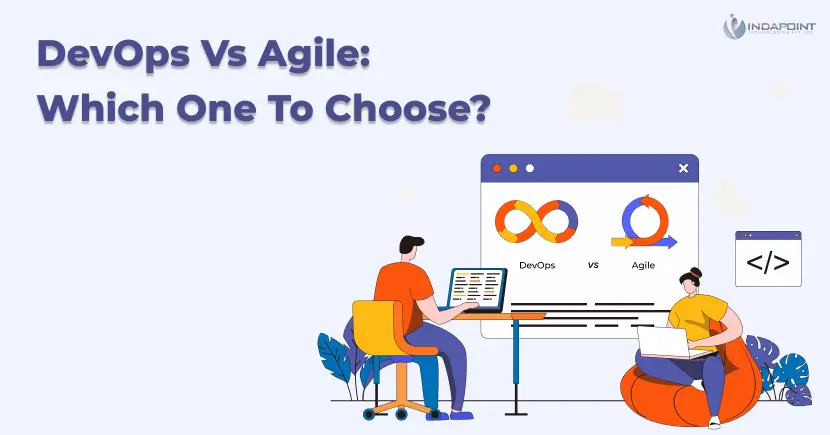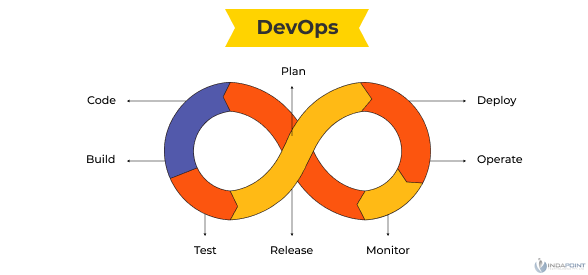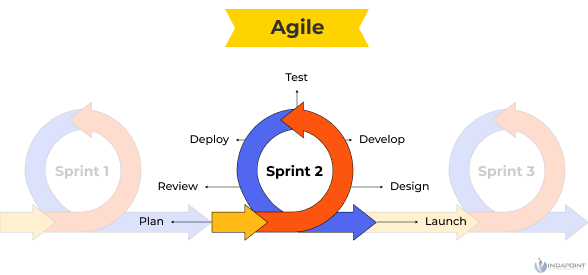DevOps Vs Agile: Which One To Choose?
July 26, 2022

Agile and DevOps are two software development approaches with identical goals: releasing the finished product as rapidly and effectively as possible. Although many businesses are keen to use these techniques, there is frequently some misunderstanding between the two.
What Is DevOps?

DevOps is a software development strategy that continuously modifies IT operations and business improvements to increase productivity and foster better teamwork. The combination of people, procedures, techniques, DevOps tools, and innovation known as DevOps enables rapid and automated code deployment.
In contrast to conventional software development approaches, which include one-time activities, DevOps is a continuous building, testing, delivering, and monitoring process. DevOps’ main goal is to consistently and correctly deploy high-quality programming. DevOps integration has many benefits, including more quickly, reliably, and conveniently integrated deployments.
The DevOps principles underpin the DevOps principles by six key core ideologies—consistent integration, continuous delivery, continuous testing, continuous deployment, persistent operations, and continuous collaboration. The merging of the two main business departments (operations and development) results in increased transparency and a focus on testing automation.
What is Agile?

The agile methodology, which was first published in 2001, is a way of software development. It uses twelve principles and four ideals to create an “agile” software development culture. Agile energizes reception and an initiative demeanor that values responsibility, collaboration, and self-association. In any event, when those requirements and patterns change late being developed, the agile methodology centers around adjusting advancement to shopper needs and patterns.
Key Similarities Between Agile Methodology and DevOps
Due to the rapid pace of technological innovation and steadily growing user demands, businesses must constantly seek more cutting-edge approaches and answers to problems. Consequently, it becomes essential for modest fields, like IT software development, to adapt to changes and novel circumstances.
Agile techniques were developed due to the shortcomings of waterfall methodologies, which failed to meet the demands of the modern world. By safely distributing the product as soon as it has been built, something that Agile techniques dislike, DevOps completes a lost component of the Agile process and advances it. Given that one is a logical development of the other, it is safe to say that the DevOps and Agile approaches share a great deal in common.

Methodology & Application
Software development methodologies include agile. While adhering to agile, the development team exclusively concentrates on developing and releasing the programme. DevOps, on the other hand, makes use of dependable, pre-built software that can be delivered quickly. DevOps isn’t engaged with the product improvement process. DevOps designers can utilize the cascade technique to develop the application.
A Predilection for Business Efficiency
DevOps and Agile collaborate to achieve one common goal for organizations: increasing efficiency. Agile and DevOps both use a business-focused approach. Teams have the chance to concentrate on a single goal when the Agile technique is used in the software development process, allowing them to gain time and become more effective. However, combining DevOps principles leads to quicker deployment and deliveries without impeding corporate operations.
Creates Space For Powerful Organizations
Despite their many differences, DevOps and Agile place tremendous emphasis on creating a collaborative work environment where employees stick together to exchange information, recognise problems as they arise, and handle them helpfully and effectively. Collaboration between coworkers and users is highly valued in order to become more useful, skilled, and adaptable.
The planning approaches
The way in which these app development procedures plan is also different. According to the Agile methodology, developers create new updates and versions at predetermined regular intervals. The entire duration of this operation was referred to as the Sprints. The developers are given a limited period during which they must additionally create certain necessary capabilities. Additionally, they must enhance the app while updating functionality in response to user feedback from the previous sprint.
DevOps was chosen for deployment to improve business processes. For business optimization in the first scenario, changes can be deployed as soon as they become visible, or you can wait until they are all visible before deploying them all at once. In contrast, DevOps developers do not have a limited amount of time for the deployment of updates but instead strive for maximum business operations.
Interaction and Documentation
Undoubtedly, the scrum stands out among the widely used techniques for applying the Agile methodology. Scrum is typically a framework primarily used for accomplishing challenging and more demanding tasks.
But although it was initially developed primarily to create applications, it now assists in completing difficult tasks. Assigning tasks becomes easier for the project manager or team member as a result. With it, a team may focus more easily on improving communication by scheduling daily meetings where each person gives an update on the job they have completed and what needs to be finished.
Influence of DevOps
In the field of software development, this philosophy has proved innovative. Many enormous organizations use DevOps to mechanize their cycles in general and make better, more keen items. Even large and small businesses, like Flipkart, Ola, Grofers, and others, have begun integrating the DevOps culture throughout the entire life cycle to raise the caliber of their products. Profits increase with increased effectiveness!
Influence of Agile
A flourishing, broad organization with several teams in place for varied responsibilities finds it challenging to transition to the Agile methodology. However, it can be advantageous if carried out properly, as demonstrated by British Telecoms, the National Bank of Canada, Lego, and many others.
Final Thoughts
We may conclude from the description above that Agile is primarily used for developing applications, while DevOps is primarily used for deploying those applications.
However, DevOps need not take the place of Agile.Therefore, avoid becoming confused and believing that Agile and DevOps are interchangeable terms. No, they are not. They might have a few characteristics, but overall, both are distinguished by their distinctions.






